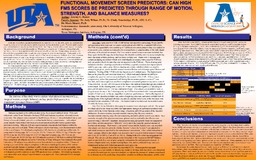
ATTENTION: The works hosted here are being migrated to a new repository that will consolidate resources, improve discoverability, and better show UTA's research impact on the global community. We will update authors as the migration progresses. Please see MavMatrix for more information.
Show simple item record
| dc.contributor.author | Hester, Jeremy L. | en_US |
| dc.date.accessioned | 2011-07-08T18:23:01Z | en_US |
| dc.date.available | 2011-07-08T18:23:01Z | en_US |
| dc.date.copyright | 2011-05 | en_US |
| dc.identifier.uri | http://hdl.handle.net/10106/5619 | en_US |
| dc.description.abstract | There has been a steady increase in sport participation in the U.S. over the recent years, and with increases
in activity comes a rise in the physical demands of sport on the musculoskeletal system. These demands coupled
with increased sport activity can yield an increase in the risk of injury. Functional movement occurs in everyday
life, and even more so in an athletic population. When these movements are imbalanced or biomechanically
inefficient, breaks in the proper kinetic chain of movement will begin to occur. Compensatory movement will
follow the bodies physical deficits, so early detection or proper intervention are important. During activity the
human body will initiate movement through the path of least resistance; meaning inefficient functional movement
can increase chances of acute injury through compensatory musculoskeletal activation or lead to microtrauma
through the wear and tear of joint tissues from repeated improper fundamental movement of the musculoskeletal
system. If problems exist with one link of the kinetic chain, problems are then carried to the following link; this
forces the second link to alter its normal function in the activated kinetic chain.
The Functional Movement Screen (FMS) is a movement test that incorporates essential functional
movement patterns and categorizes an individual’s efficiency to complete them on an ordinal scale in an attempt to
predict an individual’s readiness to safely engage in activity or sport. If outcomes could be predicted using
physical measures, health professionals would be able to quickly predict an individual’s score for the FMS.
Showing predictive physical measures that test the requirements of an FMS would allow the ability to increase
specificity of training programs aimed at increasing functionality. When an individual increases their capability to
produce correct functional movement they decrease their risk of injury, so it would be possible that by increasing a
programs ability to produce such movement by focusing on deficits in the predictive areas we can decrease their
risk for injury. Also, if the FMS were predictable untrained individuals in FMS assessment could assess
functionality. To our knowledge no current research has attempted to find predictive measures of performance on a FMS. | en_US |
| dc.description.sponsorship | Wilson, Judy Ph.D. | en_US |
| dc.description.sponsorship | Trowbridge, Cindy Ph.D. | en_US |
| dc.description.sponsorship | Ricard, Mark Ph.D. | en_US |
| dc.language.iso | en_US | en_US |
| dc.subject.other | Functional Movement Screen | en_US |
| dc.title | Functional Movement Screen Predicators: Can High FMS Scores be Predicted through Range of Motion, Strength, and Balance Measures? | en_US |
| dc.type | Presentation | en_US |
| dc.publisher.department | Neuromuscular Research Laboratory, The University of Texas at Arlington. | en_US |
| dc.publisher.department | Texas Metroplex Institute, Arlington, TX. | en_US |
| dc.publisher.department | Department of Kinesiology, The University of Texas at Arlington. | en_US |
| dc.publisher.department | Exercise Science Research Laboratories, The University of Texas at Arlington. | en_US |
Files in this item
- Name:
- Hester.pdf
- Size:
- 776.5Kb
- Format:
- PDF
This item appears in the following Collection(s)
Show simple item record


